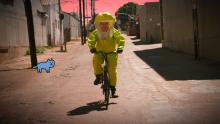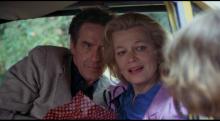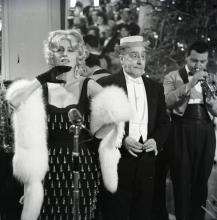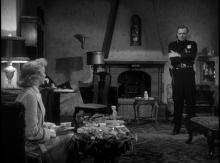This essay on Bob Fosse's film of the Broadway musical Sweet Charity was written by Cinematheque staff member Amanda McQueen. A screening of a 35mm print of Sweet Charity will kick off three weeks of unusual musicals from 1969 on Friday, January 29 at 7 p.m. in the Cinematheque's regular venue, 4070 Vilas Hall.
By Amanda McQueen
Upon its release in April 1969, Universal declared Sweet Charity "The musical with the pulse of today." In many ways it was. It was part of the cycle of roadshow musicals that escalated following the unprecedented success of The Sound of Music (1965). Its plot, as Variety explained, "cater[ed] nicely" to the "nihilistic and cynical" attitude of the late-1960s. And its visual style, inspired by youth-oriented movies like The Graduate (1967), was decidedly contemporary. Memorable and unusual, Sweet Charity is indeed a hallmark of its generation.
The musical takes its story from Federico Fellini's Nights of Cabiria (1957), which stars Fellini's wife, Giulietta Masina, as a prostitute vainly searching for true love. Conceived by director-choreographer Bob Fosse as a vehicle for his own wife, Gwen Verdon, and adapted for the stage by Neil Simon, with songs by Cy Coleman and Tin Pan Alley legend Dorothy Fields, Sweet Charity retained the basic plot of Fellini's film, including its bittersweet ending. But the protagonist, now called Charity Hope Valentine, did have her occupation changed to the less sordid dance hall hostess. Charity debuted on Broadway in January 1966. In October, Universal purchased the film rights for $500,000, and hired Fosse—who’d never directed a film before, but who did have Hollywood musical experience—to transfer his show to the big screen.
Conflicts soon arose over what approach to take to Charity’s somewhat risqué and cynical subject matter. I.A.L. Diamond (Billy Wilder’s regular collaborator) drafted the initial screenplay, which moved closer to Fellini's original. Producer Ross Hunter objected, believing that Charity should be glossy and cheerful—something akin to his previous musical, Thoroughly Modern Millie (1967). So Diamond was replaced by Peter Stone (Charade [1963]). Then, in November 1967, during the early stages of pre-production, Hunter and Fosse had a similar clash of artistic vision. Citing "serious and irreconcilable differences . . . between the director and me," Hunter bowed out, and veteran Univeresal producer Robert Arthur took over.
Principle photography began in January 1968. In May, the crew traveled to New York City for twelve weeks of tricky location shooting; in the canyons of Wall Street, for example, Fosse and Oscar-winning cinematographer Robert Surtees (Ben-Hur [1959], The Graduate [1967]) had only twenty minutes of useable daylight. Fearing further studio objections to his musical's lack of pure optimism, Fosse also shot an alternate ending, in which Charity finds her happily-ever-after, but Arthur, claiming total faith in the first-time director, approved the original ending. At a final negative cost of $10 million—$3 million over budget—Sweet Charity was Universal's most expensive film since Spartacus (1960).
Charity needed to be a hit; Universal was struggling financially and Hollywood was on the brink of recession. But many critics found the musical over-long, over-produced, and miscast—the same complaints lobbed at most big-budget adaptations of the 1960s. After a few strong opening weeks, Charity's box office returns dropped. Maybe audiences agreed with the critics. Or maybe the marketplace was just overly-saturated; over the course of its run, Charity had to compete with seven other roadshow musicals, all vying for the same, increasingly limited audience. To try and revitalize the film's performance, Universal re-vamped its ad campaign. To capitalize on the vogue for films with more explicit sexual content—and ignoring the G rating from the MPAA—Universal emphasized Charity's prostitution angle with taglines like "Meet the pros" and "Men were their business." The new approach made little difference.
In spite of its poor box office performance, however, Sweet Charity has a great deal about it to recommend. There are Coleman and Fields' classic songs, including three new ones—"Sweet Charity," "My Personal Property," and "It's a Nice Face"—written specifically for the film. There’s Fosse’s Tony-winning choreography, best showcased during “The Rich Man’s Frug.” And there are stellar performances: the film debut of the incomparable Chita Rivera; cameos by Ricardo Montalban and Sammy Davis Jr.; and a Golden Globe-nominated turn by Shirley MacLaine as Charity Hope Valentine. MacLaine had been attached to the project from the very beginning and seemed an ideal choice: she was a popular young star with a musical theater background and a penchant for playing sympathetic, lovelorn women. Gwen Verdon, who served as an uncredited assistant choreographer, rehearsed the role extensively with her, and Fosse insisted that although MacLaine lacked some of Verdon's natural dance ability, "she makes up for [it] in her enthusiasm and drive." Variety thought Charity was MacLaine's "finest and most versatile performance to date."
Finally, Charity boasts a bold and expressive visual style. Employing a wide range of in-vogue techniques—zooms, freeze frames, rhythmic editing, tinting—Charity looks like no other Broadway adaptation of the time. Variety gushed that "In one giant step, Fosse has become a major film director . . . Atop his remembered [choreographic] style is a brilliant, film-oriented appreciation of the emphasis possible only with camera and movieola." Cue Magazine similarly proclaimed that Charity was "exactly the kind of shot in the arm so desperately needed for the world of movie musicals." Admittedly, it can sometimes feel like Fosse is an unsupervised kid playing with a camera, and the director did later concede that perhaps Charity had "too many cinematic tricks in it. I was trying to be kind of flashy. That's a pitfall on your first film." But Charity’s flashy tricks are a lot of fun, and there are undoubtedly moments when they demonstrate, as The New York Times put it, that "by golly, Fosse had got it . . . he was making a real movie musical."
In October 1968, Variety wrote, "It's an accepted fact of film history that the most innovative and influential directors of musicals came from choreographic origins." Fosse proved this with Sweet Charity, joining the ranks of Busby Berkeley, Stanley Donen, and Gene Kelly. His follow-up film, the Oscar-sweeping Cabaret (1972), permanently enshrined him in the halls of film musical history. As a directorial debut, Sweet Charity is not as polished as Cabaret, but it is more surprising and more exuberant. And it absolutely captures the pulse of 1969.










